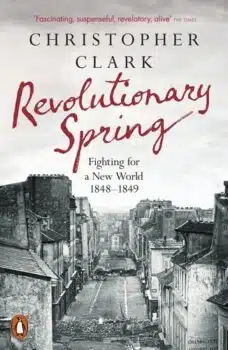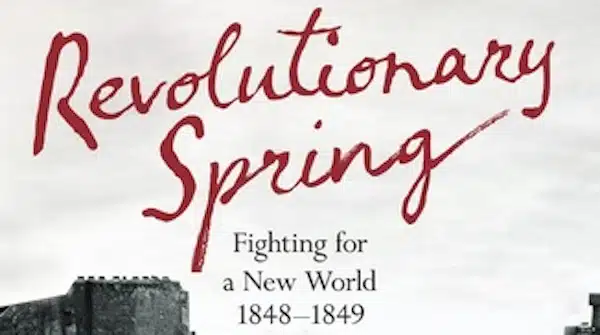
Christopher Clark, Revolutionary Spring: Fighting for a New World 1848–1849, Allen Lane, 2023.
Revolutionary Spring challenges the persistent and powerful historical view of the revolutions of 1848—49 as failures. Yes, they began tumultuously, dramatically, full of enthusiasm and dreams of new and better worlds; yes, they were relatively quickly undone, variously destroyed by internal divisions, and by increasingly violent and sophisticated policing.
Yet the notion of “failure” persists, argues Clark, because in retrospect these revolutions have been appropriated into national narratives. This enables singular treatments, depriving them of the historically transformative and Europe-wide upheavals they were.
Clark begins by creating a detailed and layered backdrop of “economic precarity”, filth, disease, unrestrained labour exploitation, huge wealth, mass poverty, inequalities, social tensions and conflicts, rural and urban divides, a Europe alive with critics and dissidents “not locked into finished worldviews”, a Europe where social orders were straining and waiting to break.
Against this he explores the revolutions with respect to their local roots, individualities and non-linear courses. Individual as they were, they took place simultaneously across a vast continental geography. Clark explores this and the ways they were linked. It is a huge task, and Clark’s book is not a hurriedly cobbled together work. The result of years of research and writing, its origins are in his earlier studies of European history.
Characterising the revolutions as the mid-nineteenth century’s “particle collision chamber”, Clark argues they became an “unfinished revolution”, a watershed from which Europe did not recover. This latter term should be read poetically in a political way, the sense being that the revolutions opened up the future. Not only to nationalism, the general historiographical preference, but robustly to liberative possibilities: ideas and notions about liberalism, radicalism, democracy, republicanism, socialism, social rights; the emancipations of women, slaves, Jews; the nature of government; the tactics of resistance and revolt; how to bring about social change. And some of these will always be works in progress.
The revolutions ended with counter-revolutionary policing, the counter-revolutionary forces able to build alliances which the revolutionaries failed to do. Vicious “cleansing” reprisals followed. Traditionally, Britain is portrayed as having escaped the turmoil of the period, the main dissident contender being Chartism. The line is that Chartism was too fractured with internal divisions to hold together, that the savvy British ruling class let air out of the balloon with gradual reform concessions, that the Chartists were good-natured folk after all. Well no, says Clark. Robust and mass policing involving regular police, huge troop deployments, and specially recruited constables with licence to use violence smashed the movement. Ireland was contained similarly. As Clark shows, the British model of policing became one informing continental counter-revolutionaries. Besides, Clark observes, Britain also had the offshore safety valve of its Empire and deportation to help thwart dissidence.
As Clark winds up his narrative, traces of those revolutionaries who survived the reprisals leave tracks. Some variously went quiet, changed politics, pulled their heads in and worked through the system, went underground, while a diaspora of radicals with ideas in their heads and luggage, spread globally and helped make histories elsewhere.
Running to 873 pages, Revolutionary Spring is a weighty tome. The canvas is vast. Clark is imaginatively at home in the Europe of the time, a rich tapestry of empires, kingdoms, states, principalities, ethnicities, demographies, all geopolitically unique with their own cultures, traditions and histories.
Maps at the front of the book assist the reader navigate this Europe before empires were variously dismantled and geographies reshaped by nationalism. Clark shows how the revolutionary zeal and political energies of the period went beyond continental Europe, ripples and convolutions variously experienced in Britain, the French Caribbean, Latin America, the United States, even colonial Australia. Readers may be surprised to find the colonies of New South Wales and Victoria part of Clark’s canvas. Discussing the impact of the 1848—49 Revolutions, he deftly includes the Eureka Stockade and Australian constitutional reform as parts of the fallout.
While Clark is a European historian, with one of the history world’s top gigs as Regius Professor of History at Cambridge University, he is also an Australian. Schooled in Australia, he took his first degree at Sydney University in the 1980s. The Free University of Berlin and Cambridge followed.
In part at least, it seems to me, in the art of the book’s creation and writing there is the spirit of EP Thompson, in the way Clark handles the galaxy of players with agency across class divides, many unfamiliar and needing concise biographical detail to make them part of the account; and in his understandings of dissident culture in poetry, song, broadsheets, pamphlets, newspapers, meetings, conversations, in formal and in informal sites like pubs, cafés, streets. Clark is on record elsewhere respectfully referring to Thompson as a “great British historian”.
Revolutionary Spring ends with 113 pages of References and Index. The References reveal the huge and diverse amount of material Clark has drawn on, multilingual material that crosses all manner of divides.
Before these there are three pages of Acknowledgements. Clark has drawn on many fellow scholars and friends for expertise, advice and comment. Some have granted access to works in progress, and works in pre-publication stages. This points to collegial trust and sharing often absent in modern academia. Clark notes that conversations are indispensable in knowledge production, and he acknowledges these individually. It is a pleasure to see this, since this tends not to be valued by the modern systems and metrics that manage scholarship.
Revolutionary Spring is an impressive work. Reader-friendly, scholarly, it is an invitation to, and demonstration of, a long view of history. It eloquently counters a historical tradition that gives failure hegemonic import, and which paves ways for shadows of futility and despair to hover over radical dreaming and activism. For people on the right side of history, in a time when a great deal of energy, power and politics is destructively and mischievously fed into generating messages of despair and end times, Revolutionary Spring is worth consideration; a book for our times.

